Removing air from the heating system: how to bleed air
The appearance of air jams in the heating system is accompanied by uneven heating of devices and alarming noise in the pipeline. The coolant moves along the circuit “jerkily”, the likelihood of water hammer increases. Agree, any sensible owner would like to exclude these phenomena.
To eliminate and prevent the above negative allows a simple action - the removal of air jams from the heating system. How to do it? Learn how to correctly assemble the circuit, which devices should be installed so that the air is removed in a timely manner, you will learn from our article.
The information presented for reference is based on regulatory documentation. We have described all the possible methods used against the formation of air congestion. To optimize the perception of the material supplemented by photo selections, diagrams, videos.
The content of the article:
Why are air jams dangerous?
Air ingress water heating system - The phenomenon is very common. And you should respond to it immediately. Although some air in the system may not seem dangerous, it often causes more serious problems.
And sometimes the airiness of the radiator or pipes allows you to identify breakdowns or flaws in the installation of the heating system.
The presence of air jams usually manifests itself in the form of uneven heating of individual elements of the system, for example, radiators.
If the device is only partially filled with coolant, its operation can hardly be called effective, since the room does not receive part of the thermal energy, i.e. not warming up.
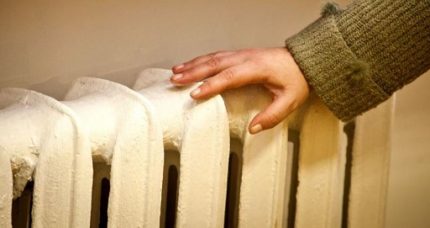
If air has accumulated in the pipes, it interferes with the normal advancement of the coolant. As a result, the operation of the heating system can be accompanied by a rather strong and unpleasant noise.
Sometimes a part of the system starts to vibrate. The presence of air in the circuit activates various chemical processes, for example, it can cause decomposition of calcium and magnesium bicarbonate compounds.
This leads to the formation of carbon dioxide, which violates the acid-base balance of the coolant. Increased acidity contributes to increased corrosion effects on the elements of the heating system, which can lead to a noticeable reduction in their service life.
In addition, chemical processes that occur under the influence of high temperature cause deposition of limestone deposits on the walls of pipes and radiators, creating a dense coating.
As a result, the lumen of the pipe decreases, the characteristics of the heating system change, it works with less efficiency. A large amount of limescale can completely clog the pipes, they will have to be cleaned or even completely replaced.

If in heating circuit included circulation pump, the presence of air in the system can adversely affect its operation. The bearings of this device are designed for permanent residence in the aquatic environment. If air enters the pump, the bearing will operate in dry running mode, which will cause it to overheat and break.
Causes of Excess Air
There are many reasons for the appearance of air; it is quite difficult to completely avoid this phenomenon. Nevertheless, it is necessary to study the factors under the influence of which air congestion forms in the heating system in order to minimize their effect on the system.
Most often, air enters the system:
- if the heating was originally installed incorrectly;
- if the rules for filling the heating circuit with water are not observed;
- if the tightness of the connection of individual elements of the system is broken;
- when there are no or incorrectly used devices in the system for venting;
- after repair work;
- when recovering the lost volume of coolant using cold water.
Incorrect installation of the heating system leads to its airing in those cases when the pipes are laid with the wrong slope, form loops, etc. It is best to track such areas even at the stage of designing an autonomous heating system.
Filling the circuit with water should be performed according to the principle: the larger the volume of the coolant, the lower the rate of its entry into the system. If water enters too quickly, in certain areas it can become a spontaneous version of the water seal, interfering with the natural process of displacing air from the circuit.
In places pipe and radiator connections leaks often occur. Sometimes a crack is so small that the water flowing from it evaporates almost immediately. The hole goes unnoticed, and air gradually penetrates through it, which replaces the lost volume of water.
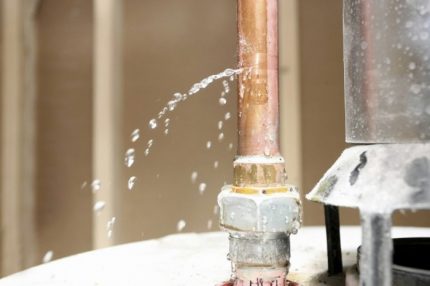
Since one way or another the circuit can still be airy, when designing heating, it is necessary to provide for the installation of special devices designed to bleed air from the heating system. If such air vents are already available but do not produce the desired effect, some of them may be broken and require replacement.
It also happens that devices for removing air are ineffective due to their improper installation or insufficient quantity. Inevitably, air will enter the system after it is repaired. In this case, you will definitely have to carry out airing measures.

If part coolant volume lost, it must be replenished. Fresh water, unlike the one already in the system, contains a certain amount of air dissolved in it. When heated, it is released in the form of small bubbles and accumulates, forming plugs.
If a fresh coolant has been added to the system, after a while it will not hurt to make sure that it is not airy anywhere.
Methods for removing air from the system
So, in order to avoid airing the heating system, it is necessary to design and install it correctly, to clean and fill it with coolant in a timely manner without unnecessary haste.
And even so, one or more air jams may still appear in the system. What to do in this case? The procedure largely depends on the design features of the heating system.
Method # 1 - compliance with the installation rules
In circuits with natural coolant circulation at the upper wiring, air is removed through open expansion tank. When installing such a system, the supply line is installed so that it rises vertically to the tank.
A tank that provides room for expansion of the coolant during heating is placed at the highest point of the system, which ensures the natural progression of the liquid along the heating circuit.
The return line should also be installed with a slope that contributes to the natural movement of the coolant flow.
If the system is mounted correctly, the air entering the circuit will gradually be displaced upward by hot water and leave the pipeline through the surface of the expansion tank that is freely connected to the atmosphere.
Method # 2 - installing air vents
The scheme for removing air from forced circulation circuits differs from the previous type. At the upper point of such a system, an open expansion tank is installed, and a closed one is placed in front of the entrance to the return boiler.
In such a system, the supply line should not have a slope, because the movement of the coolant is stimulated by the pump and other devices are used to reset the air plugs.
To remove air from the system, special automatic air vents are installed that are installed at the highest points of the system and at the turns of the pipeline.
To remove plugs from radiators, apply Mayevsky cranes. In the same way, air is removed from the heating circuit with natural circulation, but with lower piping.
With proper installation, the procedure for removing unnecessary air from the system is very simple, it boils down to opening the corresponding taps and closing them after the air jams formed in the heating system come out. Automatic air vents do not need to be opened at all. They work when pressure changes.
Closed heating circuits are supplemented by automatic air vents without fail.
They are installed along the entire circuit at certain points, which allows you to remove the air plug from the circuit locally, without waiting for the air to move to the top of the system. Such a scheme was called a multi-stage deaeration system.
The idea is to allow air to be vented for each part of the heating circuit. Typically, each radiator is equipped with a manual air vent, for example, a Maevsky tap.
If the radiator is hot from below and at the same time its upper part remains cold, then accumulated air must be removed from it.
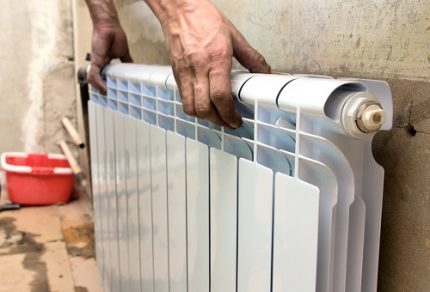
To do this, you need a wrench or screwdriver, as well as a container for collecting water and a rag for the floor. With the help of tools, the Mayevsky crane is opened and a container is placed under it. The air comes out with a characteristic hiss.
When the plug is removed, water will flow from the Majewski tap. Now the tap can be closed. In most cases, this simple procedure allows you to restore uniform distribution of the coolant throughout the radiator.
Automatic air vents are of horizontal and vertical type. They are installed in places where the likelihood of air congestion is greatest. These can be areas where the heating pipe makes a turn, a loop, etc.
Airiness of the heating system is more characteristic for the upper floors of the building, therefore, special attention should be paid to the installation of devices for venting air here.
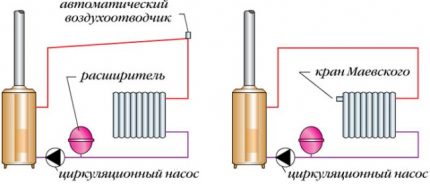
When using automatic air vents, it is important to monitor the level of pressure in the system. In addition, such devices have an increased sensitivity to pollution.
To extend the life of the automatic air vents, good filters should be installed and the heating circuit flushed regularly.
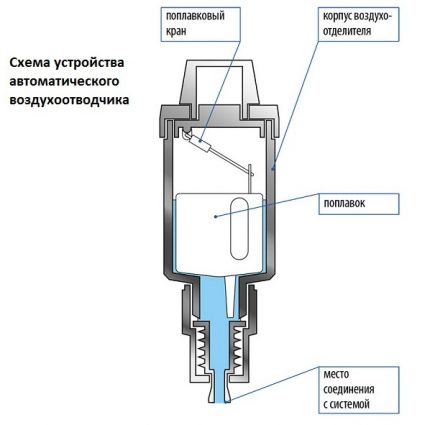
To determine the place in which air has accumulated, radiators and pipes for the start are simply felt. Where the heating temperature is noticeably lower, there is usually an air lock.
Another way to identify an airy place is to tap the contour. A small metal object is used, which is used to deliver accurate blows. In places of accumulation of air, the sound will be more sonorous.
Method # 3 - strong heating of the coolant
Sometimes, for the natural removal of excess air from the heating circuit, it is enough to heat the coolant strongly. High temperature stimulates the process of air release and its movement through the system. Water heating in the heating system is allowed up to 100 degrees.
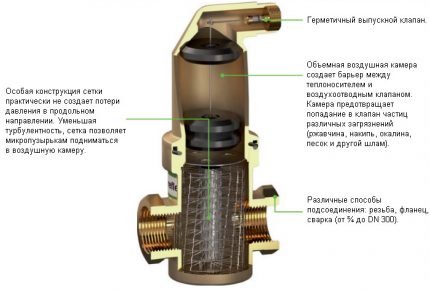
If the formation of air jams is observed in the system again and again, all joints should be examined for leaks.
Near the place where the air congestion forms, a small gap will almost certainly be found, from which water flows imperceptibly and into which air bubbles leak. Sealing up such a gap or crack will solve the problem.
The most vulnerable to air traffic jams are considered aluminum radiators. The interaction of the hot fluid with the material of the device causes the development of corrosion processes, which are accompanied by the release of gaseous substances.
If the airing of such a radiator is observed again and again, it makes sense to replace it with a more modern device with an internal anti-corrosion coating.
Filling the heating circuit with coolant
For the heating system to work correctly, it should be flushed and then re-filled with water. Often at this stage, air leaks into the circuit. This is due to improper actions during filling the circuit. In particular, air can be trapped by too rapid a stream of water, as mentioned earlier.
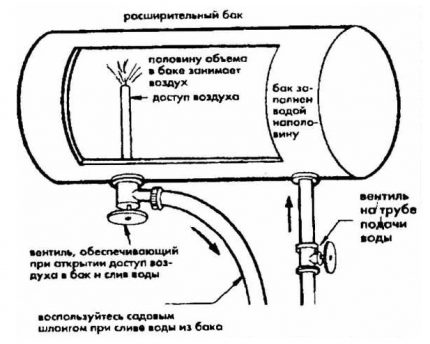
Besides, correct contour filling also contributes to faster removal of that part of the air masses that are dissolved in the coolant. To begin with, it makes sense to consider an example of filling an open heating system, at the highest point of which an expansion tank is located.
Such a circuit should be filled with coolant, starting from its lowest part. For these purposes, a shut-off valve is installed at the bottom of the system, through which tap water is supplied to the system.
In a properly arranged expansion tank there is a special pipe that protects it from overflow.
A hose of this length should be put on this pipe so that its second end is brought out to the site and is outside the house. Before filling the system, take care of the boiler. It is recommended to disconnect it for this time from the system so that the protective modules of this unit do not work.
After these preparatory activities are completed, you can start filling the circuit. The tap at the bottom of the circuit through which tap water flows is opened so that the water fills the pipes very slowly.
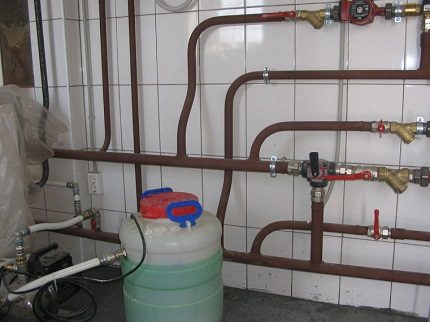
Slow filling is continued until water flows through the overflow hose out. Thereafter water tap should close. Now you need to go through the entire system and open the Majewski tap on each radiator to bleed air.
Then you can reconnect the boiler to the heating system. These taps are also recommended to open very slowly. During the filling of the boiler with coolant, a hissing sound can be heard from the protective valve for venting air.
This is a normal occurrence. After that, again, you need to add water to the system at the same slow pace. The expansion tank should be approximately 60-70% full.
After this, it is necessary to check the operation of the heating system. The boiler is turned on and the heating system is heated. Radiators and pipes are then examined to identify places where there is no or insufficient heat.
Insufficient warming indicates the presence of air in the radiators, it is necessary to again bleed it through the taps of Mayevsky. If the procedure for filling the heating circuit with coolant was successful, do not relax.
For at least another week, the operation of the system should be carefully monitored, monitor the water level in the expansion tank, and also check the condition of pipes and radiators. This will allow you to quickly resolve the problems.
In the same way, closed-type systems are filled with coolant. Water should also be fed into the system at a low speed through a special tap.
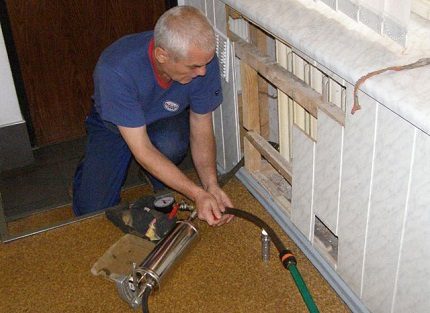
But in such systems, pressure control is an important point. When it reaches a level of two bars, turn off the water and bleed air from all radiators through Mayevsky taps. In this case, the pressure in the system begins to decrease. It is necessary to add a little coolant to the circuit so that maintain pressure at two bar level.
Performing both of these operations alone is difficult. Therefore, it is recommended to fill the closed circuit with an assistant. While one draws air from the radiators, his partner controls the pressure level in the system and immediately corrects it. Collaboration will increase the quality of this type of work and reduce their time.
Conclusions and useful video on the topic
Video # 1. A visual demonstration of the process of removing excess air from a radiator using a Maevsky crane:
Video # 2.How to bleed air from the heating circuit that does not exit through the air vent:
Air entering the heating system reduces its efficiency and may cause damage to some components.
To successfully cope with this problem, you should initially correctly install the heating or correct existing flaws. In addition, it is necessary to install air exhaust devices and comply with the rules of operation of heating systems.
Please write comments if you have any questions while familiarizing yourself with the information provided. We are waiting for your stories about your own heating device, about installing devices to remove air from the system. We invite you to comment on the material in the block below the text of the article.

 How to pressure test a heating system with your own hands
How to pressure test a heating system with your own hands  Features of flushing the heating system: an overview of the best ways
Features of flushing the heating system: an overview of the best ways 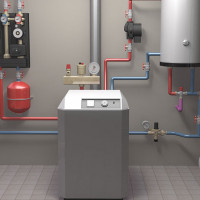 Economical heating of a private house: choosing the most economical heating system
Economical heating of a private house: choosing the most economical heating system  Distribution comb of the heating system: purpose, principle of operation, connection rules
Distribution comb of the heating system: purpose, principle of operation, connection rules 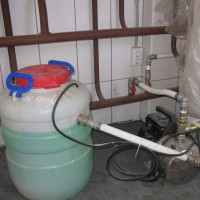 Filling the heating system with coolant: how to fill with water or antifreeze
Filling the heating system with coolant: how to fill with water or antifreeze 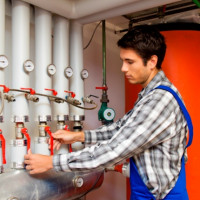 Energy-saving heating systems: how and what can be saved?
Energy-saving heating systems: how and what can be saved?  How much does it cost to connect gas to a private house: the price of organizing gas supply
How much does it cost to connect gas to a private house: the price of organizing gas supply  The best washing machines with dryer: model rating and customer tips
The best washing machines with dryer: model rating and customer tips  What is the color temperature of light and the nuances of choosing the temperature of the lamps to suit your needs
What is the color temperature of light and the nuances of choosing the temperature of the lamps to suit your needs  Replacement of a geyser in an apartment: replacement paperwork + basic norms and requirements
Replacement of a geyser in an apartment: replacement paperwork + basic norms and requirements
I am engaged in the repair and installation of heating communications. Very often there is such a problem as the airing of the system. People complain that the batteries are warm in one room and very cold in the other. The problem is easily solved: you just need to bleed air in the circuit. The article is very informative, but it doesn’t hurt to know why such situations arise.
I live in a private house, at one moment something began to click in the pipes. They said that it could be an air congestion. It was decided to drive her through the drain valve. We did not open it completely, we added heating at full capacity. He began to monitor the water in the expansion tank, periodically adding water, so that air would not enter the system again. So far so good, let's look at the next season.
What to do: in my private house the last battery is cold. I drained the water from the bottom of the return, water goes without air, it did not help.
And what if the part of the batteries is cold? I blew air through Maevsky’s taps and did not help.
Hello. Ask your question in more detail, please. What kind of “part of the batteries”, what is your heating circuit and so on. Maybe it's not in the air.
Hello. See a detailed diagram of your heating and find out how long this has been happening. As reasons, you can suggest problems with the location of the bypass when it is too far from the return line or is cut into the bends rather than in the wiring. As a result, the pressure is not enough for the coolant to enter the last radiator. There may also be a lack of balance. It is usually solved by installing temperature controllers, taps.
We have a house of the 60s, a five-story building and heating, of course, are done very stupidly, the wiring is of the old type. If the battery is too airy, then everything is cold. Only those who live on the 5th floor can blow air, because the pipe enters there, and from there it is already distributed apartment by apartment and is colder on the 2nd floor. Is there any way out of this situation?
Hello. In general, this is a headache for the Criminal Code, since the property is common house property. Write a statement addressed to the head about non-compliance with the temperature standards in the apartment, though you need to do this in the heating season for examination. In general, cranes should be installed in the attic.
Resolution of the Gosstroy of the Russian Federation of September 27, 2003N 170 “On approval of the Rules and norms of technical operation of the housing stock”:
“5.2.12. The personnel of the housing maintenance organization should systematically monitor the operation of heating systems during the heating season.
5.2.15. Air exhaust from central heating systems through air exhaust taps on heating devices should be done periodically, each time when the pressure at the inlet drops below the static pressure level of this system, and also after it is recharged, in accordance with the instructions.
5.2.17. Reliable operation of water heating systems should be ensured by the following works: - systematic removal of air from the heating system
“.